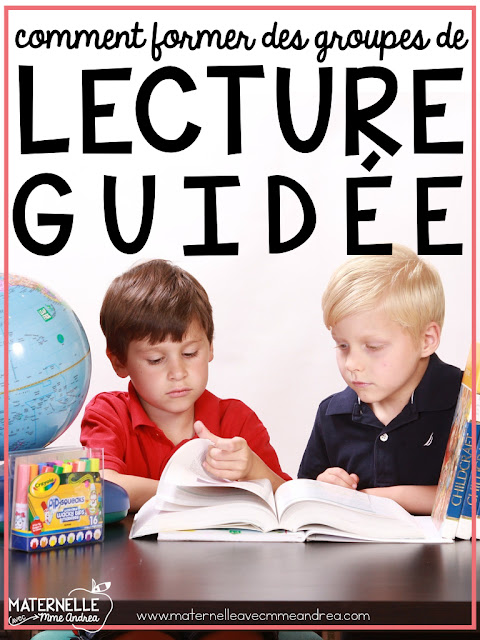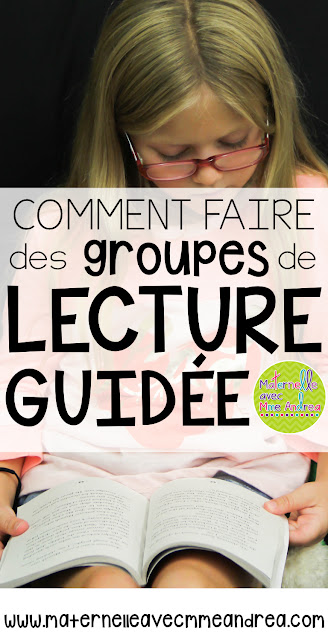Bonjour!
I am coming up to the end of our second term, and despite the plethora of snow days, being on work to rule here in Nova Scotia since December, protests and a (one-day) strike, I have been thinking a lot about guided reading lately.
Work to rule means that we do exactly what our contract specifies – no extras!! – and I had to really time-manage and prioritize in order to get all of the important things done.
And to me, guided reading is extremely important.
It is my favourite time of day, and when I see the most progress in my students. It is when I get time to work with them (mostly) undisturbed at an excellent ratio of 2:1 (two of them, one of me). It is when I get to teach them about books, and all of the funny and interesting things inside of them. It is when I get to teach them how to read!
I am currently meeting three groups of students a day, two students to a group. So, I get to read with six students each day. Work to rule meant no assemblies and no PD, so, aside from snow days, I actually got to meet with six students each day, since December 5th! And their progress has been remarkable.
Since guided reading has been such a focus for me lately, and it seems to be something that many teachers are uncomfortable with or not quite sure how to do, I have decided to write a few blog posts about what we do in my classroom – starting with how I put my groups together.
(If you are curious about what the rest of my class is doing while I meet with my groups, you can check out my blog posts about centres here. I am the only adult in my classroom, but I have my munchkins well-trained to stay on task and not disturb me!)
At this point in the year, my students have a pretty wide range of abilities. In the beginning of the year, when I first started guided reading, my students were mostly on the same page, so I had lots of time to experiment with my groups until I found the perfect matches.
It is okay to take this time!
Guided reading groups should be flexible.
My students often change groups! Sometimes, students will start at the same place, but one student will catch on to what you are teaching more quickly than their partner. Please don’t set your groups in stone, or avoid changing them if things aren’t working. Just last week, I had four students reading the same level, so I switched up their partners to give them a change. It turned out to not work well at all, despite the fact that all four girls are wonderful students and work hard no matter who their partners are. However, they had mastered and were working on different strategies, so the new pairings didn’t work. So, I switched them back! No biggie – but that brings me to my next point.
It’s not just about the level.
Many teachers seem to feel that students must be grouped by level. And one level four student should be automatically able to be grouped with any other level four student. However, this is not the case! You don’t have to have your students at the same level or reading the same book during your guided reading lesson – although I do find it much easier to read the same books at the same time and aim for that as much as possible. But…
It is more important to group students based on the strategies they need to work on.
My new groups above didn’t work because in each group, one of the girls was great at decoding, but struggled hugely with fluency. The other girls read with beautiful fluency, but were reluctant to try decoding new words. I had to switch my groups back to be able to work on fluency with one group, and decoding strategies with the other. Being at the same level does not necessarily mean that students need to work on the same strategies!
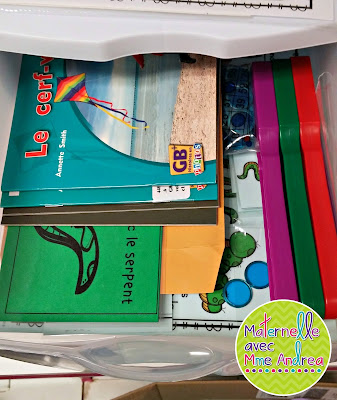 |
| A peek inside one of my guided reading drawers! |
Think about what you can manage.
My students are in groups of two because that is what I can manage. When I add another student or two to my groups, I feel like I am not reaching every student in the same way. Yes… I may be able to see them more often. But, I feel that the quality of my teaching declines when I add more bodies. However, if you feel you do your best teaching with a group of four, do it! Think about your classroom and your students’ needs, as well as what helps you be your best.
So, what specifically do I look at when I am grouping my students?
I look at lots of things! If my students are readers, then I look at their level first. I often have enough students at or around the same level to be able to play with my groups a bit. For example, I currently have four students at a level 0, two at a level 1, four at level 3, two at level 4 (but will be ready for 5 once fluency improves), two who read their first level 5 last week, and two at level 6. My two students at level 6 have been together since the very beginning – they learn in extremely similar ways and have mastered all of the same strategies, so that makes it easy on me!
Here some other things I look at to help determine my groups:
- Letters and sounds
I like my students to know at least 15 upper- and lowercase letters before even attempting to learn to read. If I have a couple of students who do not know their letters, I often group them together and use this time to do some letter and sound intervention.
 |
| I use these flash cards and send them home in my students’ reading bags. Click on the picture to find them on TPT! |
- Sight words
Sight words are often the difference between a student at a level 0 or 1 and a level 3 – they are a huge difference maker. I can easily tell which sight words my students know because I use Apprendre les mots fréquents in my classroom. You can read more about that here. It helps me to group students who are on similar lists, because I can choose books that include the sight words they already know. When students know sight words automatically and don’t have to spend time thinking about them, it frees their brains up for decoding new words and helps their fluency!
I can also use this time to practice any sight words they find extra tricky.
- Print concepts and direction
Some students begin school having no idea about print concepts and direction. These students may require extra lessons about how to hold a book, what direction to read in, when to turn the page, etc.
You can’t learn to read if you don’t know how to handle a book!
I also find it helpful to talk about punctuation from the very beginning, and make sure they are noticing periods and exclamation marks. In higher books, we talk about commas, question marks, and how we know if someone is speaking.
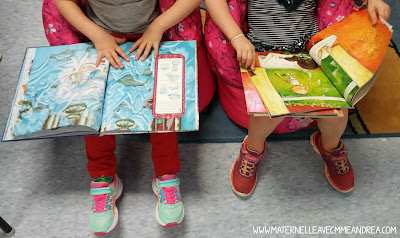 |
| Practicing turning pages in the right direction and figuring out where to start reading on each page! |
- One-to-one correspondence
This one is a biggie and usually the difference maker between my level 0 and level 1 students. Students need to understand that a word on the page is a word that you say. I am having big struggles with one of my level 0 groups currently – we have been practicing and practicing touching each word, but it hasn’t clicked yet. My other level 0 group has 1:1 correspondence down pat, but struggles in other areas.
- Fluency
I mentioned fluency above, but it is worth mentioning again. Students must learn to read with fluency! This is most easily taught if you teach it from the very beginning. However, some students forget everything you taught them about not reading like a robot once they are bumped up a level, ha! And others try a little too hard, and add expression and intonation to each word, which is just as painful to listen to. I will be back in future with a post specifically about fluency and what I do to practice it, because I think it is so important! However, I will say this now – even if a student can read a book with 95+% accuracy, if their fluency is not good, don’t bump them up a level! Keep them at their current level (or even drop them down to an “easy” book) and practice, practice, practice until they get it!
- Decoding strategies
Some students are great decoders and understand “sounding out” the first time you teach it to them. Others are reluctant to even try making the first sound in an unknown word, because they don’t like taking risks or making mistakes. I like to group my non-risk takers together, so that we can practice decoding a bunch using games, in a more “informal” setting.
You can also group them based on who has to look at each letter and make each letter sound, and who is able to see words in “chunks” and decode in syllables. A blog post is to come specifically about this skill, but you can read a bit about how I teach decoding strategies in this blog post as well.
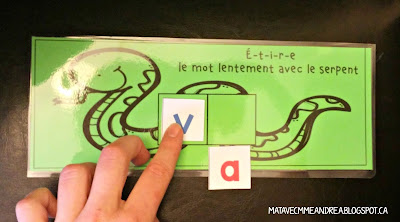 |
| These snake mats can be found in my Lecture guidée en maternelle pack. Click to see it on TPT! |
- Vocabulary
For our second-language learners, vocabulary is key. My level 3 students are grouped based on their vocabulary knowledge. I have one sweetie who speaks French at home and is miles above the rest, and another who, despite speaking no French at home, is incredibly strong vocabulary-wise. By grouping these two together, I can give them books to increase their vocabulary, and/or books whose vocabulary make them too difficult for my other group to read. We all know some of those GB+ books contain some pretty intense vocab!
Will your groups be perfect, even if you take all of these things into account?
Probably not, ha!
Some things will always be out of your control. You may have an “outlier” – for example, I once had a student who started K already reading and was miles ahead of everyone else in his grade. Luckily, I had a combined K/1 that year and could group him with a grade one, but he was even ahead of all of the grade ones for most of the year! I also have just one student who still speaks almost no French, and he is paired with a student who speaks very well. There are also some students who just do not work well together, no matter what you try. My guided reading groups are the same as my centre groups, so if students are consistently disruptive together, then I cannot group them together.
Just aim for best-fit groups! Do the best that you can with what you have. And don’t be afraid of change if something isn’t working. :)
If you are looking to know more about guided reading, please stay tuned! I have lots of information to come. In the mean time, read this blog post, which outlines the 7 strategies I teach (along with a free poster!), or this one, which talks more about how I teach my students to look at the first letter of an unknown word.


